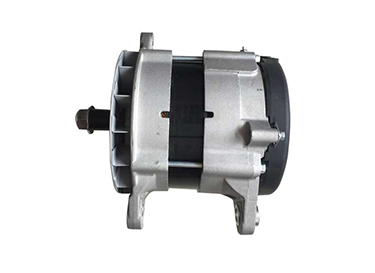Aug. 12, 2020
Alternator for trucks is the main power source of the car. Its function is to supply power to all electrical equipment (except the starter) and charge the battery when the engine is running normally (above idle speed).
As the performance of AC generators is superior to DC generators in many aspects, DC generators have been eliminated. At present, automobiles use a three-phase AC generator with a diode rectifier circuit inside to rectify AC power into DC power. Therefore, the output of the automobile alternator is direct current.
The alternator must be equipped with a voltage regulator, which controls the output voltage of the generator to keep it basically constant to meet the needs of automotive electrical appliances. China Hyundai Alternator supplier Let me analyze the structure of a card generator.
1. Rotor
The function of the rotor is to generate a rotating magnetic field. It is composed of claw poles, magnetic yoke, field winding, collector ring, and rotor shaft. Two claw poles are mounted on the rotor shaft, and excitation windings are installed in the cavity of the claw poles. The slip ring is composed of two copper rings insulated from each other, press-fitted on the rotor shaft and insulated from the shaft, and the two slip rings are respectively connected to the two ends of the excitation winding. When direct current is applied to the two collector rings, current flows through the field winding and generates an axial magnetic flux. One of the claw poles is magnetized as N pole and the other is magnetized as S pole, thus forming six pairs or Eight pairs of interlaced magnetic poles.

Alternator For Trucks
2, Stator
The role of the stator is to generate alternating current. The stator is installed outside the rotor and fixed with the front and rear ends of the generator. When the rotor rotates inside it, it causes a change in the magnetic flux in the stator winding, and an alternating induced electromotive force is generated in the stator winding. The stator is composed of the stator core and the stator winding. The stator core is made of silicon steel sheets with grooves in the inner ring and insulated from each other. The stator winding has three sets of coils, which are symmetrically embedded in the slots of the stator core. There are two types of three-phase winding connections: star and delta, generally star connection.
Three-phase windings generally adopt two types of connection: triangle (△) and star (Y). The stator winding induces and outputs a three-phase sinusoidal AC electromotive force under the action of the rotating magnetic field generated by the rotor.
3, Rectifier
The function of the rectifier is to convert the three-phase alternating current generated by the stator windings into direct current. The rectifier is composed of rectifier diodes. The rectifier of the 6-tube alternator is composed of 6 silicon rectifier diodes which are press-fitted or welded to two mutually insulated plates, one of which is a positive plate with output end bolts. ; The other is the negative plate, which is directly connected to the generator shell (grounding), or the back cover of the generator can be directly used as the negative plate. 6 rectifier diode atmosphere positive tube and a negative tube. The lead electrode is the positive electrode is called the positive tube, and the lead electrode is the negative electrode is called the negative tube. In-vehicle generators, three-phase bridge rectifier circuits are generally used as rectifiers.
Rectifiers generally have the following four forms:
4, End cover
The end cover is generally divided into two parts (front cover and rear cover), which fix the rotor, stator, rectifier, and brush assembly. The end caps are generally made of aluminum alloy casting, one is that it can effectively prevent magnetic leakage, and the other is that the aluminum alloy has good heat dissipation performance. The rear end cover is equipped with a brush assembly, which is composed of a brush, a brush holder, and a brush spring. The function of the brush is to introduce a power to the field winding through the slip ring.
5. Fans and bearings
The fan blades are installed between the front cover and the pulley (the two blades of the dual-fan generator are installed on the rotor inside the generator), and when the generator is working, it plays a role of forced ventilation and heat dissipation.
Previous: Knowledge of Automotive Alternators
Navigation
Name: Carrie Zhou
Tel: +023-68886580
WeChat: 0086-13650592877
E-mail: carrie@autopartstf-ws.com
Skype: transfortune
WhatsApp: +86 136 5059 2877
Homepage: www.autopartstf-ws.com